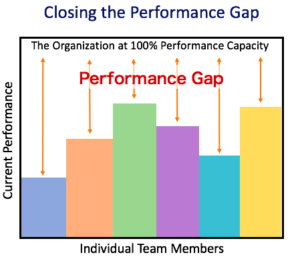7.1 Connecting Individual Performance to Organizational Success

Individually, we feel safer, more secure, and more valuable when we are in synchrony or aligned with our team in service of a meaningful cause. Clarity about the mission and strategic direction of the organization is the source of the alignment. That said, we do like the autonomy to think and act in ways we feel are best for the team. In this post, as we continue our examination of Reinforcing Systems, Pillar VII in the Foundation of Greatness, we will focus on how organizational success is connected to individual team member success.
Motivators for Peak Performance
What is it that enables individual team members to perform at peak performance? Based on our experience working with leaders, we support Dan Pink’s findings shared in his book Drive. Pink identified three motivators of humankind as:
Autonomy – the desire to be self-directed, to lead our own lives. For example, an individual is given a goal, objective, or destination to reach with the resources to do so, and the independence to determine how to achieve success, honoring the organization’s core identity.
Mastery – the desire to improve, to get better at a skill that is meaningful to us.
Purpose – to work in alignment with what makes our life meaningful and is deeply satisfying. We are intrinsically motivated to make a positive difference. This shared-purpose motivation is why organizational fit for each team member is vital. As shared in earlier posts, this is the source of power behind great teams I learned first-hand from Bo Schembechler, who did this so well as Head Football Coach at the University of Michigan.
Pink shares that carrot-and-stick incentives work in physical/mechanical jobs where speed in the assembly of a component is rewarded for higher production. However, time and again, research has shown that, when complex decision-making is required, rewards connected to output only do not work. Incentives for many of today’s white-collar jobs are counter-productive because they are not linked to an intrinsically meaningful Purpose motivation.
For example, in the investment banking business, your purpose may be “to help clients become financially safe and secure.” Many firms pay brokers a commission based on the dollars invested, without correlation to the return provided to the investor. With no connection to the purpose, immature brokers, focused on competitive fulfillment (Stage II Comparative Fulfillment (see our blog post “The Four Stages of Fulfillment—An Overview”), may get short-term gratification from their commission.
Straight commission-based compensation misses the deeper, more meaningful fulfillment of providing financial security for their customers which, if accomplished, should provide a more secure stream of income for the broker. Team compensation based on returns to the investors is one way to build great teams and connect with the purpose of the firm. More Wall Street firms like Merrill Lynch, RBC, UBS, Morgan Stanley, and Smith Barney are using team-based incentives to compensate, as they are finding greater team member and client stability, along with alignment to organizational purpose.
Reinforcing Performance and Organizational Fit
The Performance Evaluation Equation we shared in an earlier blog post and shown here is a reinforcing system that assesses individual fit to the organizational Core Identity as part of regular performance evaluations. We find that this is an accelerator for cultural alignment. A deeper understanding of individual fit with organizational Core Identity results when evaluators use real examples or stories of fit, or lack of fit, to justify their objective rating. This process paints vivid pictures of what perceived acceptable and unacceptable behavior looks like, and it enables individuals to see others’ perspectives of their fit objectively. At the same time, as the assessor is evaluating others, they may look in the mirror and ask themselves how they would rate themselves on each component.

Real examples or stories of perceived alignment can reinforce an individual’s perception or provide them with a new perspective. In either case, the opportunity to be more purposeful in the future is provided in pictures that stick, not metrics we can rationalize and dismiss.
Reinforcing systems that support greater self-awareness can help develop a differentiating asset required in leaders. When we ask teams what would benefit their leaders most, they say a leadership 360° assessment. To be exemplary, leaders need reinforcing systems that help develop a curious and outward mindset that seeks to understand the perspective of others.
Leadership 360° assessments are a win-win for the organization. The evaluator and the evaluatee both gain a deeper understanding of their role in honoring the organization when at its best.
Establishing objective key metrics is an essential part of an organization’s Reinforcing Systems; there should be a set of key metrics at the individual (scorecard), department (scoreboard), and organization (dashboard) levels. Our next post will discuss objective key metrics more thoroughly, but we will round out this post on individual alignment by touching on the individual scorecard.
The Individual Scorecard
The Individual Scorecard monitors how the individual is strategically impacting the Department Scoreboard. This reinforcing system helps team members get into the game in service of each other and the department. Individual Scorecard components for consideration may include:
Attendance
Excessive missed work creates more opportunity for communication breakdown and a lack of individual alignment to the organization. We find disengaged team members who may not feel valued miss more work. Sick days can be an indicator of a lack of fit in the job or the organization, and due to the harmful stress, there is a physical impact on team members’ health in the short term and life in the long run.
Individual 360° Performance Evaluation
Referenced in Blog Post 6.5 on assessing teams, 360° assessments share the employee’s status on Organizational Culture Fit, Job Competency Fit, and Job Behavioral Fit. Comparing the average of the six-to-eight evaluators to overall department and company averages, along with the individual’s self-evaluation, reveals areas of most significant growth opportunity and areas of strength. Those with exceptional strengths may benefit the organization by mentoring others.
Leadership Questions
- Do team members have the flexibility and opportunity to find better routes to achieve goals?
- Do team members have the resources needed to do their work and be successful?
- Are you objectively measuring individual contribution to the Department Scoreboard?
This post is part of series drawn from Fritz Seyferth’s upcoming book on the Foundation of Greatness.






